 |
 |
 |
| |
Mutations associated with cross-resistance to tipranavir in patients previously treated with two or more protease inhibitors
|
| |
| |
Reported by Jules Levin
5th European HIV Drug Resistance Workshop
Cascais, Portugal
March 29, 2007
J Scherer1, VM Kohlbrenner1, DB Hall1, JD Baxter2, J Schapiro3, CAB Boucher4
1Boehringer Ingelheim Pharmaceuticals, Ridgefield, CT, USA; 2Cooper Hospital/UMDNJ-Robert Wood Johnson Medical School, New Jersey, USA;
3National Hemophilia Center, Israel; 4Department of Virology, University Medical Center Utrecht, the Netherlands
ABSTRACT
Purpose of the Study: Efficacy of protease inhibitor (PI) regimens is limited by PI cross resistance. Tipranavir (TPV) is active against PI-resistant HIV-1. The RESIST trials showed that highly treatment-experienced (HTE) patients taking TPV/r had significantly greater responses than patients taking comparator PI/r. Baseline PI cross-resistance patterns were evaluated.
Methods: 520 baseline viral isolates from HTE patients in RESIST and 1182.51 studies were analyzed for phenotypic drug sensitivity to TPV, lopinavir (LPV), amprenavir (APV), saquinavir (SQV), indinavir (IDV), nelfinavir (NFV) and atazanavir (ATZ) using Antivirogram. For evaluation of cross-resistance, fold change (FC) in IC50 above which clinically significant resistance was determined: 5.4 for TPV, 9.6 for APV, 26.5 for SQV, 40.1 for IDV, 7.3 for NFV, 2.4 for ATZ, and 56.1 for LPV. Pairwise comparisons of mutation frequencies allow identification of key mutations for differentiating between virus resistant to TPV and previously used PIs and virus still susceptible to TPV.
Summary of Results: 71-78% of isolates resistant to other PIs were susceptible to TPV. The mutation 50V is observed in 6-12% of isolates resistant to other PIs that were susceptible to TPV and is not observed in isolates resistant to both.
Other mutations that are more prevalent in isolates resistant to other PIs that were susceptible to TPV include 24I 17-23% vs 3-8%, 48V 10-29% vs 5-8%, 82S 2-5% vs 1%, 54T 3-9% vs 0-1%, and 54S 5-9% vs 2-4%. Similarly, 82A is found in 46-57% of those susceptible to TPV while resistant to other PIs, compared with 27-34% of those resistant to both.
For those resistant to both TPV and the other PIs, 53-87% had 84V, while 19-43% of those resistant to other PIs and susceptible to TPV had 84V. Other mutations with lower prevalence, but similar patterns indicating cross resistance are 47V 32-37% vs 5-19%, 54M 16-21% vs 4-13%, 74P 6-10% vs 1-2%, and 89V 21-25% vs 9-13%.
Conclusions: PI associated mutations at 24I, 48V, 50V, 54S, 54T, and 82A contribute to indication of sustained susceptibility to TPV for patients with virus resistant to other marketed PIs. Other mutations in resistant isolates suggesting resistance to both TPV and other PIs include 84V, 89V, 54M, 47V, and 74P.
Introduction
Protease inhibitors (PIs) have significantly impacted the morbidity and mortality of HIV disease progression since their introduction to the medical market in the late 1990s. PIs are potent agents, however, the HIV-1 protease gene is mutation-prone, leading to the appearance of resistant viral variants. Tipranavir (TPV) is a novel, non-peptidic protease inhibitor of the human immunodeficiency virus (HIV-1) protease. It has been shown that TPV retains activity against more than 90% of PI resistant isolates [1]. Decreased susceptibility to TPV (defined as >4 fold wild type [WT]) was associated with multiple protease mutations, which included mutations at positions 13, 35, 43, 58, 69, 74 and 83,which suggested a resistance profile of TPV at least partially distinct from that of other PIs. Mutations that lead to resistance of other PIs do not appear to have the same impact on TPV. Further, multiple specific protease mutations are needed to confer reduced phenotypic susceptibility and decreased virologic response to TPV, suggesting a high genetic barrier to the development of resistance to TPV [2]. The patterns of cross-resistance of TPV and commercially available PIs and their genotypic characterizations are presented here.
Methods
Baseline isolates from the Phase 3 TPV program (Trials 1182.12 [RESIST1], 1182.48 [RESIST2]), and the phase 2b Trial 1182.51) that were assayed both phenotypically and genotypically were the basis for this analysis (n=523)
[3,4].
Patients in these trials had previously been treated with at least 2 commercially available protease inhibitors, but not TPV (note: commercially available at time of initiation of the RESIST program in 2003).
Resistance testing with Virco Antivirogram phenotype assay produced an IC50 fold change from reference virus for the following protease inhibitors: amprenavir (APV), atazanavir (ATV), indinavir (IDV), lopinavir (LPV), nelfinavir (NFV), saquinavir (SQV), and TPV.
Patterns of cross-resistance are presented graphically in scatter plots (Figures 1-6) to demonstrate the relationship between phenotypic susceptibility to TPV and the commercially available protease inhibitor. Each graph shows the fold change from wild type for TPV (x-axis) and for the commercially available PI (y-axis).
To aid in analysis of distribution of isolates a vertical line is inserted corresponding to a TPV change from wild type of 5.4 and an horizontal line was inserted corresponding to a change from wild type of 9.6 for APV, 26.5 for SQV, 40.1 for IDV, 7.3 for NFV, 2.4 for ATZ, and 56.1 for LPV. With the exception of ATZ (clinical cut-off not available at the time of these analyses), these values correspond to the upper clinical cut-offs reported for the vircoTYPE virtual phenotype. The virtual phenotype clinical cut-offs are used in order to have cutoffs derived in a consistent manner across all PIs.
To evaluate genotypic and phenotypic correlations, IAS mutations were analyzed individually and the percentage of viruses (1) susceptible to both the commercial PI and TPV, (2) resistant to the commercial PI but susceptible to TPV, or (3) resistant to both the commercial PI and TPV was calculated [5]. Numbers were insufficient for analysis of the viruses susceptible to the commercial PI but resistant to TPV.

Results
Less than 50% of patients had virus susceptible to the first generation PIs, while 80% had virus susceptible to TPV (Figures 1-6). See tables, figures below.
The relationship between phenotypic susceptibility to TPV and each commercially available PI (Figures 1-6) shows that >70% (range 71%-78%) of viruses resistant to comparator PIs were susceptible to TPV. For each PI, fewer than 6% of isolates were resistant to TPV but remained sensitive to a commercially available PI. In contrast, the relationship between LPV and APV (Figure 7) shows that 52% of viruses are resistant to both. Since there were so few isolates resistant to tipranavir and susceptible to the other PIs, prevalence by mutation results are not presented for this group of isolates.
Three patterns of mutations were evident (Table 1).
1. Cross resistant: Mutations were most prevalent in virus that was resistant to both TPV and the comparator PI (CPI). As an example, 84V shows this pattern across all CPIs, with prevalence of over 50% in virus resistant to both TPV and CPI, with less prevalence in the other two cells (<30% in virus susceptible to both for all CPIs and a range of 27% to 43% across CPIs in virus susceptible to TPV and resistant to CPI).
2. TPV neutral: Mutations were most prevalent in virus resistant to the comparator PI and equally prevalent whether the virus was resistant or susceptible to TPV. As an example, 73S shows this pattern for all CPIs except APV, with around 25% of virus resistant to CPI (regardless of resistance to TPV) with considerably less prevalence in virus susceptible to both TPV and CPI.
3. Discordant: Mutations were most prevalent in virus that was resistant to the comparator and susceptible to TPV. As an example, 48V shows this pattern for all CPIs except APV, with prevalence of 15% to 29% in virus resistant to CPI but susceptible to TPV and very low prevalence (²10% in all cases) in virus resistant or susceptible to both.
Mutations at 24I, 48V, 50V, 54T and 82A were most prevalent in viruses that were resistant to the other PIs and susceptible to TPV (Figures 8-12). Other mutations that contribute to indication of sustained susceptibility to TPV for patients with virus resistant to CPIs include 53L and 54S (Table 1).
Mutations at 13V, 43T, 47V, 82T, 84V, and 90M were more prevalent in viruses that were resistant to both TPV and the other CPIs (Figures 13-18), although 90M was prevalent in all cells indicating it is more of a signature mutation for a highly mutated virus rather than one that can help identify a cross-resistant virus. Other mutations in resistant isolates suggesting resistance to both TPV and other CPIs include 89V, 54M, 33F, 32I and 74P (Table 1).
While several TPV score mutations were more prevalent when the virus was resistant to TPV, their prevalence while the virus was still susceptible to TPV indicates that multiple TPV score mutations are needed to confer TPV resistance (Table 1). For example, while 34% of TPV susceptible isolates have the 13V mutation, only 47% of TPV resistant isolates have this mutation.
Conclusions
TPV maintains phenotypic susceptibility against the majority of HIV-1 clinical isolates resistant to other PIs.
Mutations that confer cross-resistance or produce a discordant result can distinguish between a virus that is resistant to both TPV and another PI and a virus that is resistant to another PI while remaining susceptible to TPV.
PI associated mutations at 24I, 48V, 50V, 53L, 54S, 54T, and 82A contribute to indication of sustained susceptibility to TPV for patients with virus resistant to other marketed PIs. Other mutations in resistant isolates suggesting resistance to both TPV and other PIs include 13V, 43T, 47V, 54M, 74P, 84V, and 89V.

Notes on Table 1:
1. Entries in table are the percentages of isolates in that column (both susceptible (TPV-S/CPI-S), CPI resistant and TPV susceptible (TPV-S/CPI-R), or both resistant (TPV-R/CPI-R)) that have the mutation indicated by the row (e.g. of 136 isolates that are susceptible to both LPV and TPV (TPV-S/LPV-S), 15% have the mutation 10F).
2. Mutations occurring with a frequency of <10% are not shown unless a notable difference between TPV-S/CPI-R and TPV-R/CPI-R observed.
3. TPV score mutations are indicated by a * after the mutation.
4. The following shading is added to help the reader identify the mutations showing the three patterns described in the results section:
Cross resistant, highest prevalence with both resistant
Related to resistance to other PI, susceptibility to TPV
Related to resistance, with similar prevalence whether resistant to TPV or susceptible to TPV
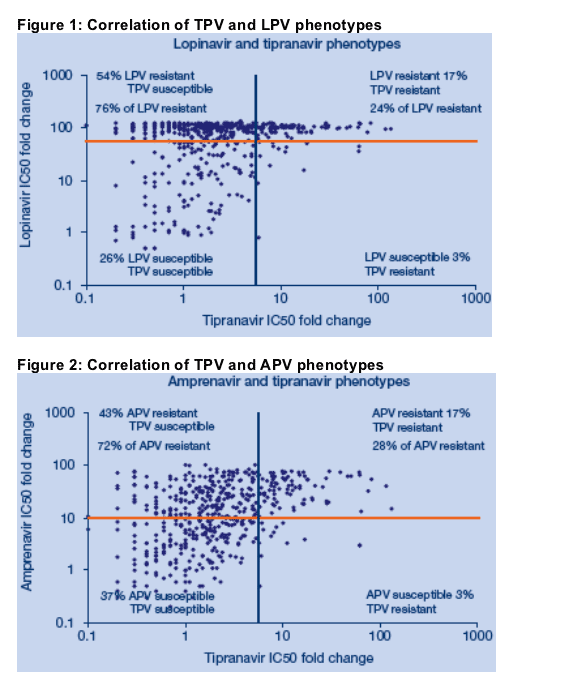
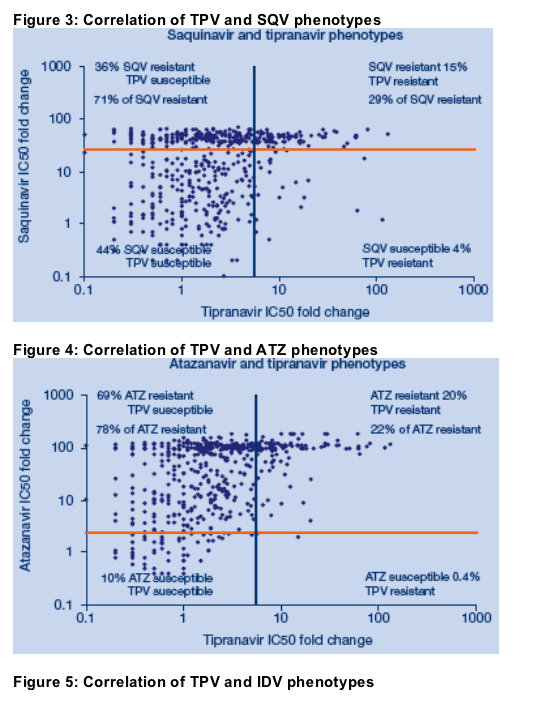
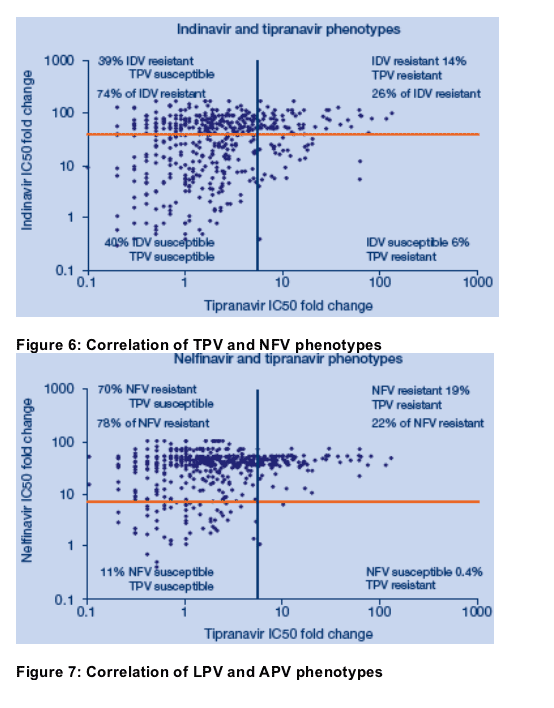
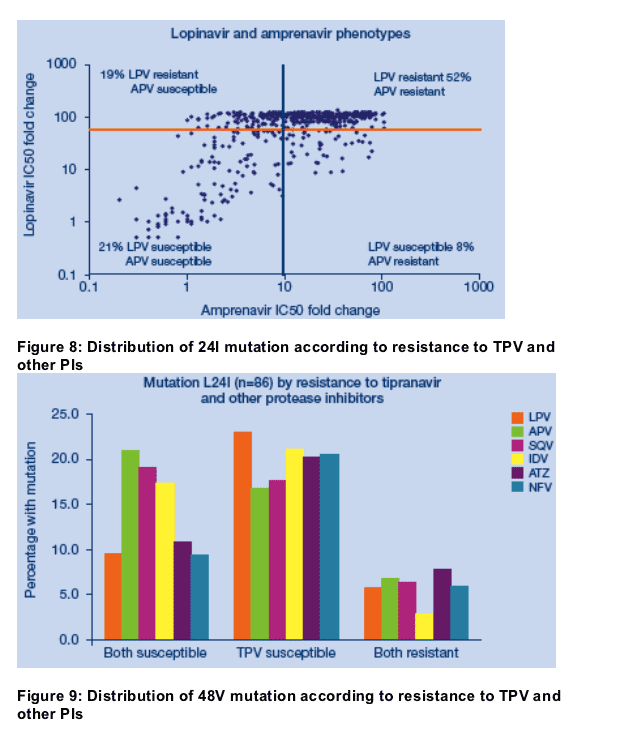
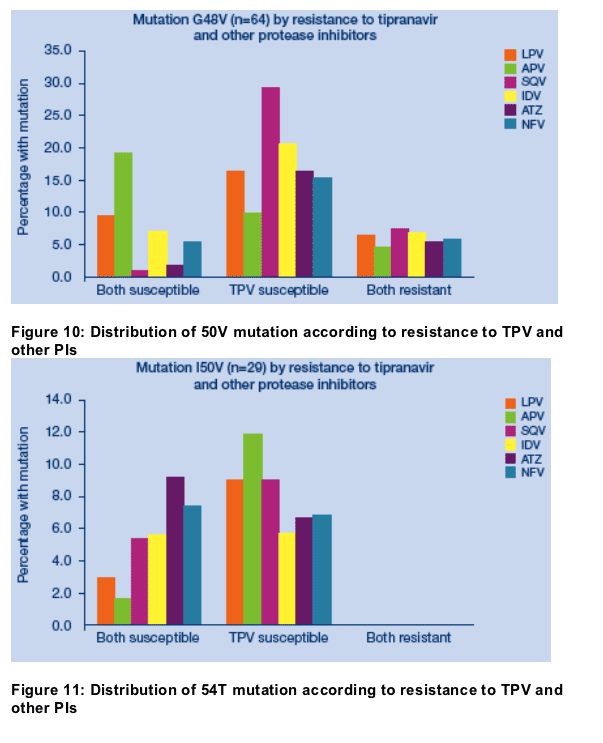
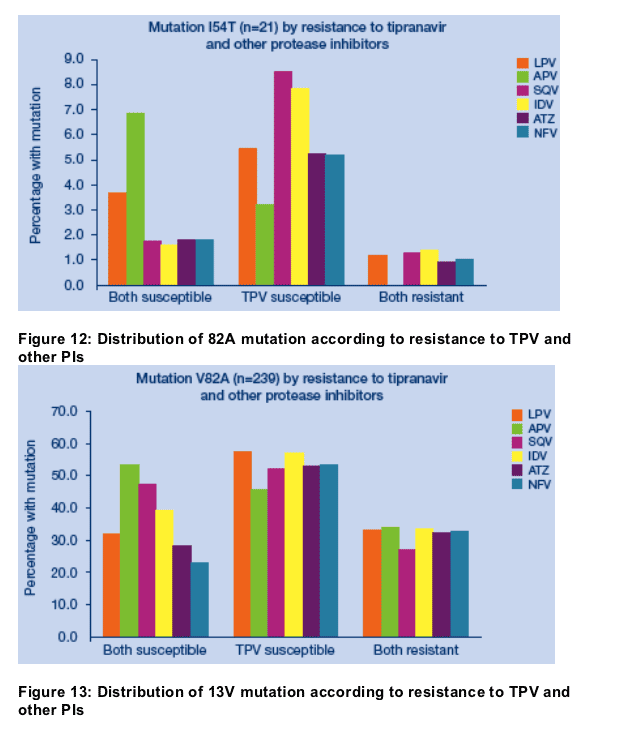

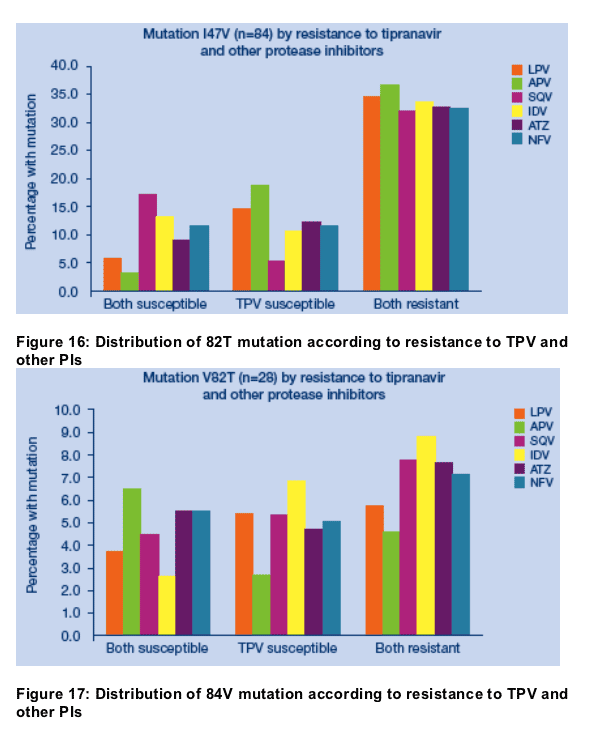
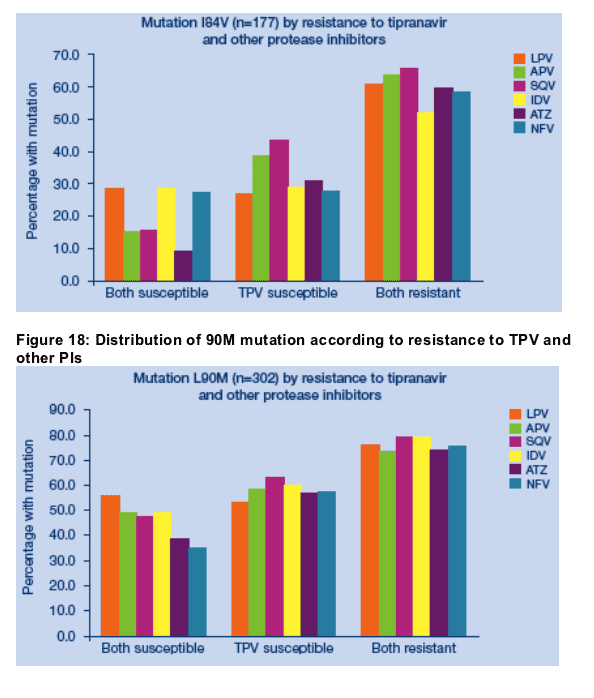
|
| |
|
 |
 |
|
|